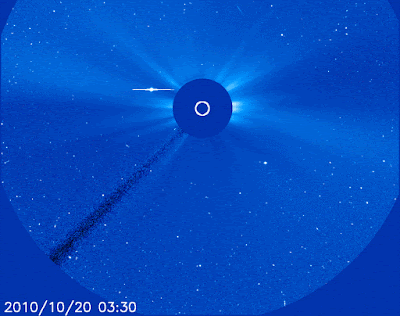IAUC nr.9174, issued on 2010, Oct. 18, announced the discovery of a new periodic comet by R. E. Hill through the Catalina 0.68-m Schmidt telescope, on images obtained on 2010, Oct. 17.3. The new comet has been designated P/2010 U2 (HILL).
We performed some follow-up measurements of this object while it was still listed in the NEO-CP, on 2010 Oct. 17.5 and 18.3, remotely from the GRAS Observatory (near Mayhill, NM) through a 0.25-m, f/3.4 reflector + CCD.
Analysis of two different series of 10 unfiltered stacked images, 120-seconds each, showed that this object appeared non-stellar. Through our images, we were unable to discriminate a definitive coma, however we measured on both nights its FWHM nearly 40% wider compared to that of nearby field stars of similar brightness, indicating a slightly diffuse nature at the threshold limit of our instrumental set-up and seeing conditions.
In our stackings of both nights, there was also a hint of elongation in a south-west to north-east direction (or the other way around, not easy to tell), while the field stars had an ordinary symmetrical profile. This might indicate the presence of a little tail or elongated coma, below our resolving power for that night (and, indeed, the discoverer reported a thin tail about 15"-20" long in p.a. 240 deg).
Our confirming image (click below for a bigger version):
This object was previously reported in a "one stand" night of observations by the "La Sagra" sky Survey, with observations dating back to 2010, oct. 1.1
Preliminary orbital elements published by the Minor Planet Center, assign to
P/2010 U2 an elliptical orbit, with: T = 2010 Nov. 9.746 TT, e = 0.40365, q = 2.55669 AU, Peri. = 44.270 deg, Node = 357.247 deg, i = 16.910 deg, equinox 2000.0, P = 8.9 years
by E. Guido, G. Sostero, L. Donato & V. Gonano











